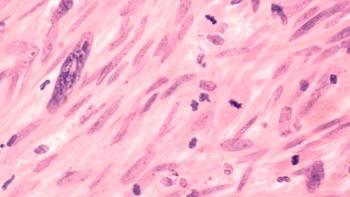
Some Sarcomas May Require Long-Term Follow-Up
Although rare, long-term recurrence of soft-tissue sarcoma is possible, and patients with retroperitoneal, very large sarcomas, or high-grade disease should undergo long-term follow-up to detect late disease recurrence.
Although rare, long-term recurrence of soft-tissue sarcoma is possible, and patients with retroperitoneal, very large sarcomas, or high-grade tumors should undergo long-term follow-up to detect late disease recurrence, according to the results of a European study
“In addition to current European Society for Medical Oncology recommendations for the first 5 years, we suggest that patients with retroperitoneal sarcoma and patients with high-grade tumors be followed biannually for up to 10 years,” wrote Maud Toulmonde, MD, from the department of medicine, Bergonie Institute, Bordeaux, France, and colleagues.
Data from the study also indicated that patients with grade 1 non-retroperitoneal disease do not need long-term follow-up.
Toulmonde and colleagues conducted this retrospective study to determine if any prognostic factors for late and metastatic soft-tissue sarcoma recurrence could be identified.
“The diversity of soft-tissue sarcoma in terms of anatomic location, histology, and biological behavior makes global analysis inappropriate,” the researchers wrote. “Early diagnosis of local recurrence or metastatic recurrence can lead to aggressive treatments with curative intent and prolonged survival in selected patients.”
The researchers analyzed data from 719 patients from the French Sarcoma Group database who were alive and disease free at least 5 years after initial disease management. They looked at the cumulative probability of late and metastatic disease with death as a competing event. Patients in the study were followed for a median of 9.1 years.
At the time of the analysis, 67 patients (9.3%) had developed late local disease recurrence and 42 patients (5.8%) had developed late metastatic disease recurrence.
Multivariate analysis of the data revealed that internal trunk location (hazard ratio [HR] = 3.9; 95% CI, 2.2-6.7; P < .001) and tumor size larger than 100 mm (HR = 2.1; 95% CI, 1.1-4; P = .035) were independently associated with an increased risk for late local recurrence. Late local recurrence occurred in 25% of patients with internal trunk sarcoma and 14% of patients with a tumor larger than 100 mm.
“Retroperitoneal sarcomas share both negative prognostic features for local recurrence,” the researchers wrote. “More specifically, retroperitoneal liposarcomas, especially when well differentiated, can have a very indolent course interspersed with iterative recurrences.”
The likelihood of late metastatic recurrence was independently linked with tumor grade greater than 1 (HR=4.7; 95% CI, 1.1-2.1; P=.04).
“Although the majority of metastatic recurrences occur within 2 years from the time of the initial diagnosis, the data from the current study indicate that 1 in 14 patients with high-grade soft-tissue sarcoma who was free of recurrence at 5 years developed a late metastatic recurrence,” the researchers wrote. “One mechanism that could explain the late recurrence of high grade, highly proliferating tumors is tumor dormancy.”
Newsletter
Stay up to date on recent advances in the multidisciplinary approach to cancer.

















































































